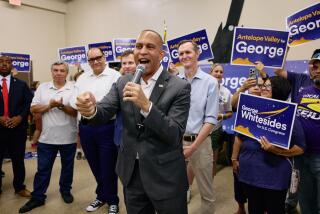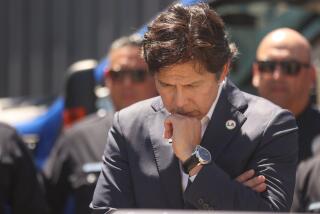Lids for the War Chests
Everyone seems to agree that there is a lot wrong with Congress. The institutional gridlock infecting the national legislative body has been reported on in depth in many journals, including a recent four-part series in The Times by Sara Fritz. Reform is offered as the cure, but few can agree on just what course reform is to take, or how it would be implemented. But there is one obvious place to start, and that is with the money.
It costs too much money to run for Congress. Incumbents spend an inordinate amount of their time raising funds for the next reelection campaign. Potential challengers get scared off because the incumbents are able to build up such huge war chests from political-action committees and other sources long before an election. In return for their money, contributors clearly get favored treatment. All they get is access, the members always protest, but access is the most important thing that a senator or congressman can provide, short of selling a vote outright.
Compiling a campaign-reform bill is a difficult task, in part because of constitutional problems--the limiting of a person’s ability to exercise his free speech through the support of the political candidate of his choice, whether by voting for him, supporting him publicly or contributing money to his campaign. But the presidential election financing law has worked well within those constitutional limits. And Common Cause and other groups have sponsored a solid California campaign finance reform measure, which will be on the 1988 ballot by initiative, that also meets constitutional tests.
For Congress the best available solution is S 2, sponsored by Senate Majority Leader Robert C. Byrd (D-W.Va.) and Sen. David L. Boren (D-Okla.), now awaiting its first debate and vote ofthe 1988 session. The key word is vote , for Byrd and Boren brought the measure before the Senate seven times last year, and each time Republicans, with the help of two Democrats, prevented any vote from being taken by use of the filibuster. This time the Senate must allow a vote.
The key provision of S 2 is that it would set limits on campaign spending ranging from just under $1 million for the Senate in the general election in the smallest states to a maximum of $5.5 million in the largest, including California. Primary-election limits would range from $636,500 to $2.75 million. There would be an aggregate limit on the amount of political-action committee contributions that a candidate could accept, ranging from $190,950 in the smallest states to $825,000 in the largest and $100,000 in each of the nation’s 435 U.S. House districts.
Candidates who agreed to the spending limits would receive certain benefits, including substantial reductions in mailing costs and in television advertising rates. To qualify for the benefits they would have to demonstrate the seriousness of their candidacies by raising a threshold amount of campaign money on their own--up to $650,000 in California.
A candidate would not have to be restricted by the limits. But if such a candidate then spent more than the limit, his opponent would receive public campaign-financing funds in the amount by which the limit was exceeded. Foes have criticized S 2 as a public campaign-financing bill, but no public money would be provided as long as both candidates agreed to abide by spending limits.
The bill contains several other needed reforms, including more stringent reporting requirements on independent campaign committees not specifically tied to an opponent. Political-action committees and parties would have to disclose so-called “soft money” contributions--for example, the providing of services like campaign consulting or computer work.
According to Common Cause, congressional campaign costs have increased fivefold since 1974--to a total of $373 million in 1986. The average Senate seat now costs $5 million to win, and political-action committees clearly have developed more clout than anyone intended when the last big campaign-reform measure was passed nearly 15 years ago.
Campaign spending is out of control, and 1988 is the time to do something about it. S 2 is the way.
More to Read
Get the L.A. Times Politics newsletter
Deeply reported insights into legislation, politics and policy from Sacramento, Washington and beyond. In your inbox three times per week.
You may occasionally receive promotional content from the Los Angeles Times.










